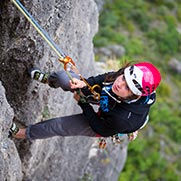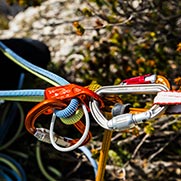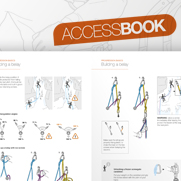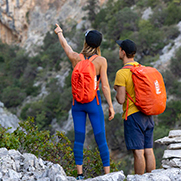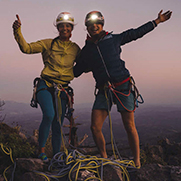Zorbey Aktuyun attests to the importance of the partner check
On February 20, climber and Turkish champion, Zorbey Aktuyun, was climbing in Turkey's Antalaya province. Following his ascent of the route "Cristal Crag" (6b), forgetting to tie a stopper knot on the free end of the rope cut his climbing outing short. After his accident, Zorbey talks about his painful experience and emphasizes the importance of always conducting a partner check.
May 26 2015
Indoor and Outdoor Climbing
What route were you on when the accident happened?
I was on "Cristal Crag," a route that is roughly 35 meters high. It was only our second route of the day, a warm up, and I was in real a hurry to warm up, which clearly was the wrong approach to take.
Can you describe to us the circumstances of the accident?
It all went so fast... The rope was too short, the route was too long, I was being careless, not paying enough attention and probably in too much of a hurry, the base of the cliff was crowed, there was a lack of organization between my partner and I as well as too many distractions, the drive to the crag the day before was too long, I started the day already tired, too much loud music, too lost in my toughts, overconfident, etc.
Zorbey Aktuyun's broken ankles. After one week at the hospital. Time to recover.
What is your analysis following the accident?
It's really important to check everything before you start to climb. You absolutely have to conduct a partner check even if you are climbing with a longtime partner. Always remember to check everything. In our case, we had two or three ropes with us and I just tied into one of them without checking. In addition, the area where your belayer is standing should always be clear of both gear and people, and if it's your first time climbing at a given area, you should be extra careful since you will likely be in a hurry and overexcited to climb a bunch of new routes (enthusiasm is a good thing, but still…). Climbing always requires paying attention, regardless of how many years of experience you have, and every climber should respect and follow the basic rules of safety in order to enjoy themselves. It is also always a good idea to carefully read through the guidebook and verify the length of the routes you plan to climb.
Is tying a knot at the end of the rope something you do on a regular basis, or rarely if ever?
In Izmir (Turkey) we have two main sport climbing areas. At one of them the routes are 25 meters high maximum, so we have the bad habit of never tying a knot in the free end of the rope when we climb there. At the other cliff several routes are 45 meters high, and since we climb their a lot, we bring a long rope and systematically tie a knot in the free end. However, when we change our routine we honestly forget to check the free end of the rope. If you go to a new area, or to a cliff where you rarely climb, especially to a spot known for its long routes like Geyikbayiri, you should always start your day climbing by tying a knot in the free end rope.
After this experience, do you have a message to share with the climbing community?
Whatever your level or experience, you are never immune from doing something that could potentially have dire consequences. Always check as many things as possible, stay well organized, and be more careful.
Included in this article
Related News


